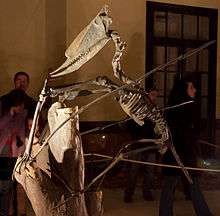Dsungaripteroidea
Dsungaripteroidea is a group of pterosaurs within the suborder Pterodactyloidea.
| Dsungaripteroids | |
|---|---|
 | |
| Restored skeleton of Dsungaripterus weii | |
| Scientific classification | |
| Kingdom: | Animalia |
| Phylum: | Chordata |
| Order: | †Pterosauria |
| Suborder: | †Pterodactyloidea |
| Clade: | †Lophocratia |
| Clade: | †Dsungaripteroidea Young, 1964 |
| Subgroups | |
Evolutionary history
The earliest known fossils attributed to this group are from the Kimmeridgian-age Upper Jurassic Argiles d'Octeville Formation of France, dated to around 155 million years ago, and belonging to the species Normannognathus wellnhoferi.[1]
Classification
The Dsungaripteroidea was defined in 2003 by David Unwin. Unwin made Dsungaripteroidea the most inclusive clade containing both Dsungaripterus weii and Germanodactylus cristatus.[2] Unwin at that time considered those two species to be close relatives. However, more recent studies have shown Germanodactylus to be much more primitive, either an archaeopterodactyloid or a primitive member of the Eupterodactyloidea. This makes Dsungaripteroidea a much larger group.
Alexander Kellner in 2003 defined Dsungaripteroidea very differently as the group containing the last common ancestor of Nyctosaurus and Quetzalcoatlus, and all its descendants. However, subsequent recent analysis use the name Ornithocheiroidea instead of Dsungaripteroidea for this definition.[3][4][5]
Paleobiology
Dsungaripteroids sensu Unwin appear to have been largely terrestrial pterosaurs. Not only do they have thick bone walls and generally stouty bodily proportions, they also occur in inland environments, usually away from the coast. Their flight style remains largely untested, but it is speculated that it was dominated by frantic flapping and abrupt landings.[6]
References
- Buffetaut, E., Lepage, J.-J., and Lepage, G. (1998). A new pterodactyloid pterosaur from the Kimmeridgian of the Cap de la Hève (Normandy, France). Geological Magazine 135(5):719–722.
- Unwin, D. M., (2003). "On the phylogeny and evolutionary history of pterosaurs." Pp. 139-190. in Buffetaut, E. & Mazin, J.-M., (eds.) (2003). Evolution and Palaeobiology of Pterosaurs. Geological Society of London, Special Publications 217, London, 1-347.
- Andres, B.; Clark, J.; Xu, X. (2014). "The Earliest Pterodactyloid and the Origin of the Group". Current Biology. 24: 1011–6. doi:10.1016/j.cub.2014.03.030. PMID 24768054.
- Upchurch, P.; Andres, B.B.; Butler, R.J.; Barrett, P.M. (2015). "An analysis of pterosaurian biogeography: implications for the evolutionary history and fossil record quality of the first flying vertebrates". Historical Biology. 27 (6): 697–717. doi:10.1080/08912963.2014.939077. PMC 4536946. PMID 26339122.
- Nicholas R. Longrich; David M. Martill; Brian Andres (2018). "Late Maastrichtian pterosaurs from North Africa and mass extinction of Pterosauria at the Cretaceous-Paleogene boundary". PLOS Biology. 16 (3): e2001663. doi:10.1371/journal.pbio.2001663. PMC 5849296 Freely accessible. PMID 29534059
- Witton, Mark (2013). Pterosaurs: Natural History, Evolution, Anatomy. Princeton University Press. p. 51. ISBN 978-0691150611.